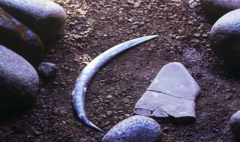New DNA evidence from a skeleton found in Egypt suggests significant migration and cultural exchange with Mesopotamia, marking a pivotal moment in the evolution of ancient societies.
Breakthrough DNA Analysis Unveils Ancient Connections Between Egypt and Mesopotamia

Breakthrough DNA Analysis Unveils Ancient Connections Between Egypt and Mesopotamia
A study of a 4,500-year-old man's skeleton reveals critical links between Ancient Egyptian and Mesopotamian civilizations, potentially reshaping our understanding of their interactions.
Researchers at Liverpool John Moores University have made a groundbreaking discovery that could significantly alter the narrative of ancient history. A DNA analysis of a man who lived approximately 4,500 years ago in the Nile Valley has revealed that he possessed genetic links to ancestors from Mesopotamia, which is present-day Iraq. This finding suggests a remarkable interconnection between two of the earliest civilizations, potentially shedding light on how Egypt evolved from scattered farming communities into one of the world's most influential civilizations.
The lead researcher, Prof. Pontus Skoglund of the Francis Crick Institute in London, emphasized the transformative potential of studying ancient DNA, stating that it allows for a richer and more detailed historical understanding. This new method of examination complements existing archaeological and textual records, traditionally dominated by elite perspectives, by providing insights into the lives of ordinary people from history.
The analysis focused on DNA extracted from a bone in the inner ear of the skeleton, which was originally found in a ceramic pottery coffin in 1902 near the village of Nuwayrat, located 265 kilometers south of Cairo. This individual, believed to have lived between 4,500 and 4,800 years ago, was likely a potter, as indicated by the analysis of his skeletal structure. The presence of significant wear from his profession and the unique shape of certain bones point toward a lifetime of labor-intensive work.
Additionally, the research offers the first substantial evidence of significant migration between the regions of Egypt and Mesopotamia during a critical period that saw the emergence of agriculture and writing systems in both societies. While previous archaeological records hinted at possible interactions, this study is the first to confirm genetic ties, bolstering theories about cultural exchange and technological diffusion.
PhD candidate Adeline Morez Jacobs noted the importance of this research for understanding the broader dynamics of ancient civilizations. The evidence suggests that as both communities developed their agricultural practices and written language, they likely shared ideas and practices, ushering in a revolutionary transformation.
The man’s burial style provides further insight into his identity, as he was laid to rest prior to the advent of artificial mummification, contributing to the DNA preservation. In addition to his ancestry and profession, scientists examined chemical markers in his teeth to uncover dietary habits that hinted at a childhood spent in Egypt.
Prof. Joel Irish studied his skeleton to paint a detailed portrait of the man’s life, describing his stature, age, and occupational habits. He suggested that the individual was around 5 feet 2 inches tall and showed signs of a physically demanding lifestyle, indicative of his profession as a potter.
The study highlights the survival of this skeleton through various historical events, such as the Blitz of World War II, which nearly destroyed much of the ancient human remains collection. The research findings have been published in the journal Nature, promising to further stimulate interest in the interconnectedness of ancient civilizations.



















